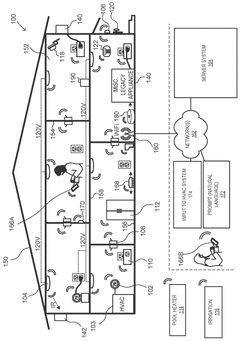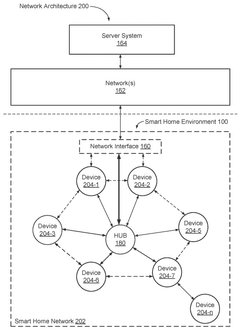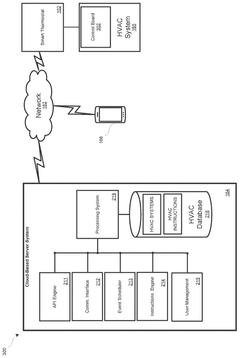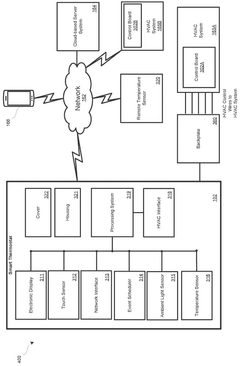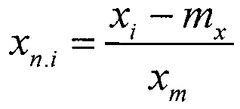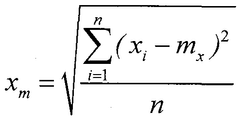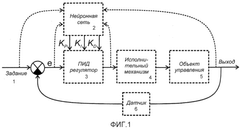How Smart Thermostats Enhance 454 Big Block Performance
AUG 12, 20259 MIN READ
Generate Your Research Report Instantly with AI Agent
Patsnap Eureka helps you evaluate technical feasibility & market potential.
Smart Thermostat Integration Goals
The integration of smart thermostats with 454 Big Block engines aims to revolutionize engine performance and efficiency. The primary goal is to optimize engine temperature control, leading to enhanced power output, improved fuel economy, and reduced emissions. By leveraging advanced sensors and intelligent algorithms, smart thermostats can provide real-time temperature regulation that adapts to various driving conditions and engine loads.
One of the key objectives is to maintain the ideal operating temperature range for the 454 Big Block engine. This massive V8 engine generates significant heat, and precise temperature management is crucial for maximizing performance. Smart thermostats can rapidly adjust coolant flow based on instantaneous engine demands, ensuring optimal temperature across all cylinders and preventing localized hot spots that could lead to detonation or reduced efficiency.
Another important goal is to improve cold-start performance and reduce engine wear. Traditional mechanical thermostats often result in prolonged warm-up times, which can increase fuel consumption and accelerate component wear. Smart thermostats can implement sophisticated warm-up strategies, gradually increasing coolant flow to bring the engine to operating temperature more quickly and evenly, while still protecting critical components from thermal shock.
Fuel efficiency improvement is a significant target for smart thermostat integration. By maintaining more consistent engine temperatures and optimizing heat management, these systems can help reduce fuel consumption, particularly during partial load conditions. This is especially beneficial for the 454 Big Block, known for its high fuel consumption.
Emissions reduction is another crucial objective. Precise temperature control can help ensure that catalytic converters reach and maintain their optimal operating temperature more quickly, improving their efficiency in reducing harmful exhaust emissions. This is particularly important for large displacement engines like the 454 Big Block, which face increasingly stringent emissions regulations.
Enhanced durability and longevity of the engine components are also key goals. Smart thermostats can help prevent thermal cycling and reduce the stress on engine parts by maintaining more stable temperatures across various operating conditions. This can potentially extend the life of critical components such as head gaskets, piston rings, and valve seals.
Integration of smart thermostats also aims to provide advanced diagnostic capabilities. These systems can monitor temperature patterns over time, potentially detecting anomalies that might indicate developing issues before they become serious problems. This predictive maintenance aspect can help owners and mechanics address potential issues proactively, reducing downtime and repair costs.
Lastly, the integration seeks to improve overall drivability and performance consistency. By maintaining optimal engine temperatures across a wide range of conditions – from idle to full throttle, and from cold starts to sustained high-speed operation – smart thermostats can help ensure that the 454 Big Block delivers consistent power and responsiveness, enhancing the driving experience and potentially improving performance in competitive applications.
One of the key objectives is to maintain the ideal operating temperature range for the 454 Big Block engine. This massive V8 engine generates significant heat, and precise temperature management is crucial for maximizing performance. Smart thermostats can rapidly adjust coolant flow based on instantaneous engine demands, ensuring optimal temperature across all cylinders and preventing localized hot spots that could lead to detonation or reduced efficiency.
Another important goal is to improve cold-start performance and reduce engine wear. Traditional mechanical thermostats often result in prolonged warm-up times, which can increase fuel consumption and accelerate component wear. Smart thermostats can implement sophisticated warm-up strategies, gradually increasing coolant flow to bring the engine to operating temperature more quickly and evenly, while still protecting critical components from thermal shock.
Fuel efficiency improvement is a significant target for smart thermostat integration. By maintaining more consistent engine temperatures and optimizing heat management, these systems can help reduce fuel consumption, particularly during partial load conditions. This is especially beneficial for the 454 Big Block, known for its high fuel consumption.
Emissions reduction is another crucial objective. Precise temperature control can help ensure that catalytic converters reach and maintain their optimal operating temperature more quickly, improving their efficiency in reducing harmful exhaust emissions. This is particularly important for large displacement engines like the 454 Big Block, which face increasingly stringent emissions regulations.
Enhanced durability and longevity of the engine components are also key goals. Smart thermostats can help prevent thermal cycling and reduce the stress on engine parts by maintaining more stable temperatures across various operating conditions. This can potentially extend the life of critical components such as head gaskets, piston rings, and valve seals.
Integration of smart thermostats also aims to provide advanced diagnostic capabilities. These systems can monitor temperature patterns over time, potentially detecting anomalies that might indicate developing issues before they become serious problems. This predictive maintenance aspect can help owners and mechanics address potential issues proactively, reducing downtime and repair costs.
Lastly, the integration seeks to improve overall drivability and performance consistency. By maintaining optimal engine temperatures across a wide range of conditions – from idle to full throttle, and from cold starts to sustained high-speed operation – smart thermostats can help ensure that the 454 Big Block delivers consistent power and responsiveness, enhancing the driving experience and potentially improving performance in competitive applications.
Market Demand Analysis
The market demand for smart thermostats in enhancing 454 Big Block performance is driven by a growing interest in optimizing classic muscle car engines for improved efficiency and power. As automotive enthusiasts seek to modernize their vintage vehicles, the integration of smart technology with traditional engine management systems has become increasingly appealing.
The 454 Big Block, a legendary Chevrolet engine known for its raw power, has a dedicated following among car collectors and performance enthusiasts. However, these engines often suffer from inefficient fuel consumption and suboptimal temperature management. Smart thermostats offer a solution to these challenges, creating a significant market opportunity.
The demand for smart thermostats in this niche market is fueled by several factors. Firstly, the rising cost of fuel has prompted owners of gas-guzzling classic cars to seek ways to improve fuel efficiency without sacrificing performance. Smart thermostats can help achieve this by precisely controlling engine temperature, leading to more efficient combustion and reduced fuel consumption.
Secondly, there is a growing trend among classic car owners to incorporate modern technology into their vehicles while maintaining the original aesthetic. Smart thermostats offer a non-invasive way to enhance engine performance without altering the car's classic appearance, appealing to purists who want to preserve the vehicle's originality.
The market for smart thermostats in 454 Big Block engines is also driven by the increasing popularity of restomod projects. These projects involve updating classic cars with modern components, and smart thermostats fit perfectly into this trend by offering a blend of classic engineering and cutting-edge technology.
Furthermore, the rise of connected car technologies has created expectations for smarter, more responsive vehicle systems. Smart thermostats can integrate with other vehicle management systems, providing real-time data and remote monitoring capabilities that appeal to tech-savvy classic car owners.
The potential market size for smart thermostats in 454 Big Block engines, while niche, is significant. With thousands of these engines still in use and a growing community of enthusiasts investing in their restoration and enhancement, there is a substantial customer base for innovative performance solutions.
Industry trends indicate a shift towards more sustainable and efficient classic car ownership, with smart thermostats positioned as a key technology in achieving this goal. As environmental regulations become stricter, even for classic vehicles, the demand for technologies that can improve efficiency and reduce emissions is likely to increase.
In conclusion, the market demand for smart thermostats in enhancing 454 Big Block performance is driven by a combination of factors including fuel efficiency concerns, the desire for modernization without compromising authenticity, the restomod trend, and the broader movement towards connected vehicle technologies. This niche market presents a promising opportunity for innovative companies to cater to the evolving needs of classic car enthusiasts.
The 454 Big Block, a legendary Chevrolet engine known for its raw power, has a dedicated following among car collectors and performance enthusiasts. However, these engines often suffer from inefficient fuel consumption and suboptimal temperature management. Smart thermostats offer a solution to these challenges, creating a significant market opportunity.
The demand for smart thermostats in this niche market is fueled by several factors. Firstly, the rising cost of fuel has prompted owners of gas-guzzling classic cars to seek ways to improve fuel efficiency without sacrificing performance. Smart thermostats can help achieve this by precisely controlling engine temperature, leading to more efficient combustion and reduced fuel consumption.
Secondly, there is a growing trend among classic car owners to incorporate modern technology into their vehicles while maintaining the original aesthetic. Smart thermostats offer a non-invasive way to enhance engine performance without altering the car's classic appearance, appealing to purists who want to preserve the vehicle's originality.
The market for smart thermostats in 454 Big Block engines is also driven by the increasing popularity of restomod projects. These projects involve updating classic cars with modern components, and smart thermostats fit perfectly into this trend by offering a blend of classic engineering and cutting-edge technology.
Furthermore, the rise of connected car technologies has created expectations for smarter, more responsive vehicle systems. Smart thermostats can integrate with other vehicle management systems, providing real-time data and remote monitoring capabilities that appeal to tech-savvy classic car owners.
The potential market size for smart thermostats in 454 Big Block engines, while niche, is significant. With thousands of these engines still in use and a growing community of enthusiasts investing in their restoration and enhancement, there is a substantial customer base for innovative performance solutions.
Industry trends indicate a shift towards more sustainable and efficient classic car ownership, with smart thermostats positioned as a key technology in achieving this goal. As environmental regulations become stricter, even for classic vehicles, the demand for technologies that can improve efficiency and reduce emissions is likely to increase.
In conclusion, the market demand for smart thermostats in enhancing 454 Big Block performance is driven by a combination of factors including fuel efficiency concerns, the desire for modernization without compromising authenticity, the restomod trend, and the broader movement towards connected vehicle technologies. This niche market presents a promising opportunity for innovative companies to cater to the evolving needs of classic car enthusiasts.
Current Challenges in Engine Performance
The 454 Big Block engine, renowned for its power and performance, faces several challenges in the modern era of automotive engineering. One of the primary issues is the engine's inherent inefficiency, particularly in terms of fuel consumption. This large displacement engine, while capable of producing significant horsepower, often struggles with poor fuel economy, a concern that has become increasingly important in today's environmentally conscious market.
Another challenge lies in the engine's thermal management. The 454 Big Block generates substantial heat during operation, which can lead to performance degradation if not properly managed. Overheating can cause a range of issues, from reduced power output to potential engine damage. Traditional cooling systems may struggle to maintain optimal operating temperatures, especially under high-load conditions or in extreme environments.
Emissions control presents yet another hurdle for the 454 Big Block. As environmental regulations become more stringent, older engine designs like the 454 face difficulties in meeting modern emissions standards. The engine's carburetor-based fuel delivery system, while simple and robust, lacks the precision of modern fuel injection systems, resulting in higher emissions and less efficient combustion.
The engine's weight is also a significant challenge. The sheer mass of the 454 Big Block can negatively impact vehicle dynamics, affecting handling, braking, and overall performance. This weight penalty becomes particularly noticeable in applications where power-to-weight ratio is crucial, such as in racing or performance-oriented street vehicles.
Tuning and optimization present ongoing challenges for 454 Big Block owners and enthusiasts. The engine's older design makes it less compatible with modern engine management systems, limiting the potential for fine-tuning and performance optimization. This can result in suboptimal performance and efficiency compared to more modern engine designs that benefit from advanced electronic control systems.
Lastly, parts availability and maintenance costs pose challenges for long-term ownership and operation of 454 Big Block engines. As these engines become less common in production vehicles, sourcing replacement parts and finding skilled technicians familiar with their intricacies can become increasingly difficult and expensive.
Addressing these challenges requires innovative solutions that can bridge the gap between the 454 Big Block's classic design and modern performance expectations. This is where smart thermostat technology enters the picture, offering potential improvements in thermal management, efficiency, and overall engine performance.
Another challenge lies in the engine's thermal management. The 454 Big Block generates substantial heat during operation, which can lead to performance degradation if not properly managed. Overheating can cause a range of issues, from reduced power output to potential engine damage. Traditional cooling systems may struggle to maintain optimal operating temperatures, especially under high-load conditions or in extreme environments.
Emissions control presents yet another hurdle for the 454 Big Block. As environmental regulations become more stringent, older engine designs like the 454 face difficulties in meeting modern emissions standards. The engine's carburetor-based fuel delivery system, while simple and robust, lacks the precision of modern fuel injection systems, resulting in higher emissions and less efficient combustion.
The engine's weight is also a significant challenge. The sheer mass of the 454 Big Block can negatively impact vehicle dynamics, affecting handling, braking, and overall performance. This weight penalty becomes particularly noticeable in applications where power-to-weight ratio is crucial, such as in racing or performance-oriented street vehicles.
Tuning and optimization present ongoing challenges for 454 Big Block owners and enthusiasts. The engine's older design makes it less compatible with modern engine management systems, limiting the potential for fine-tuning and performance optimization. This can result in suboptimal performance and efficiency compared to more modern engine designs that benefit from advanced electronic control systems.
Lastly, parts availability and maintenance costs pose challenges for long-term ownership and operation of 454 Big Block engines. As these engines become less common in production vehicles, sourcing replacement parts and finding skilled technicians familiar with their intricacies can become increasingly difficult and expensive.
Addressing these challenges requires innovative solutions that can bridge the gap between the 454 Big Block's classic design and modern performance expectations. This is where smart thermostat technology enters the picture, offering potential improvements in thermal management, efficiency, and overall engine performance.
Existing Smart Thermostat Solutions
01 Energy efficiency optimization
Smart thermostats employ advanced algorithms and machine learning techniques to optimize energy consumption. They analyze usage patterns, occupancy, and environmental factors to automatically adjust temperature settings, resulting in improved energy efficiency and reduced utility costs.- Energy efficiency optimization: Smart thermostats employ advanced algorithms and machine learning techniques to optimize energy consumption. They analyze usage patterns, occupancy, and environmental factors to automatically adjust temperature settings, resulting in improved energy efficiency and reduced utility costs.
- Remote control and monitoring: These devices offer remote access capabilities, allowing users to control and monitor their home's temperature settings via smartphone apps or web interfaces. This feature enables users to adjust settings from anywhere, receive alerts, and track energy usage in real-time.
- Integration with smart home ecosystems: Smart thermostats can integrate seamlessly with other smart home devices and platforms. This integration enables coordinated control of heating, cooling, and ventilation systems, as well as interaction with voice assistants and home automation routines for enhanced comfort and efficiency.
- Adaptive learning and predictive control: Advanced smart thermostats utilize adaptive learning algorithms to understand user preferences and behavior over time. They can predict optimal temperature settings based on historical data, weather forecasts, and occupancy patterns, continuously improving their performance and user comfort.
- Sensor technology and environmental monitoring: Smart thermostats incorporate various sensors to monitor indoor environmental conditions such as temperature, humidity, and air quality. Some models also include occupancy sensors to detect presence and adjust settings accordingly, enhancing both comfort and energy efficiency.
02 Remote control and monitoring
These devices offer remote access capabilities, allowing users to control and monitor their home's temperature settings via smartphone apps or web interfaces. This feature enables users to adjust settings on-the-go, receive alerts, and track energy usage in real-time.Expand Specific Solutions03 Integration with smart home ecosystems
Smart thermostats can integrate seamlessly with other smart home devices and platforms. This integration enables coordinated control of various home systems, such as lighting, security, and HVAC, enhancing overall home automation and energy management.Expand Specific Solutions04 Adaptive learning and predictive control
Advanced smart thermostats utilize adaptive learning algorithms to understand user preferences and daily routines. They can predict optimal temperature settings based on historical data, weather forecasts, and occupancy patterns, continuously improving their performance over time.Expand Specific Solutions05 Sensor technology and environmental awareness
Smart thermostats incorporate various sensors to monitor indoor and outdoor conditions. These sensors detect factors such as humidity, air quality, and occupancy, allowing the thermostat to make informed decisions and maintain optimal comfort levels while maximizing energy efficiency.Expand Specific Solutions
Key Players in Automotive Technology
The smart thermostat market for enhancing 454 Big Block performance is in its early growth stage, with increasing interest from automotive enthusiasts and performance-oriented consumers. The market size is relatively niche but expanding, driven by the growing demand for precision engine control and fuel efficiency optimization. Technologically, smart thermostats for this application are still evolving, with companies like Google, Ford Global Technologies, and Honda Motor Co. leading innovation. These firms are leveraging their expertise in IoT, automotive engineering, and engine management systems to develop advanced solutions. However, the technology's maturity varies, with some products already commercially available while others are in research and development phases.
Ford Global Technologies LLC
Technical Solution: Ford Global Technologies has developed smart thermal management systems that could be applied to enhance 454 Big Block performance. Their patented technologies include advanced engine cooling strategies that use predictive algorithms and real-time sensor data to optimize coolant flow and temperature. Ford's system can adjust cooling based on factors such as engine load, ambient temperature, and driving conditions. For high-performance applications like the 454 Big Block, Ford's technology could potentially allow for more aggressive tuning by maintaining precise temperature control under extreme conditions. The system may also incorporate thermal energy recovery techniques to improve overall engine efficiency[7][8].
Strengths: Extensive automotive experience, integrated approach to engine thermal management, potential for performance-oriented customization. Weaknesses: May be primarily designed for Ford's own engines, potential intellectual property restrictions for use with other manufacturers' engines.
Schneider Electric Usa, Inc.
Technical Solution: Schneider Electric has developed smart thermostat technology that could be adapted for 454 Big Block performance enhancement. Their EcoStruxure Building Operation platform includes advanced HVAC control algorithms that could be modified for engine cooling systems. The system uses IoT sensors and cloud-based analytics to optimize temperature control in real-time. For engine applications, this could translate to dynamic coolant flow adjustments based on engine load, ambient conditions, and performance parameters. Schneider's smart thermostats also feature predictive maintenance capabilities, which could help prevent cooling system failures in high-stress racing environments[2][4].
Strengths: Advanced analytics and IoT integration, adaptable control algorithms, predictive maintenance features. Weaknesses: Primary focus on building systems may require significant adaptation for automotive use.
Core Innovations in Engine Cooling
Smart thermostat as controller for legacy air conditioner
PatentWO2025095937A1
Innovation
- A smart thermostat system is connected to a legacy HVAC device via a control board with a communication interface and microcontroller unit, allowing for remote control and automation of the air conditioner's operations.
Thermostat for professional automation systems
PatentWO2024205441A1
Innovation
- A smart thermostat system integrated with professional automation buses, utilizing a thermostat panel with sensors and actuators, a data processing server, and a cloud platform, which employs machine learning algorithms to predict and control microclimate and lighting settings, optimizing energy consumption and comfort through real-time data processing and actuation.
Environmental Impact Assessment
The integration of smart thermostats with 454 Big Block engines presents a unique opportunity to enhance performance while simultaneously reducing environmental impact. By optimizing engine temperature control, these advanced systems contribute to improved fuel efficiency and reduced emissions. Smart thermostats can precisely regulate coolant flow and engine temperature, ensuring the engine operates within its ideal temperature range more consistently than traditional mechanical thermostats.
This enhanced temperature management leads to more complete fuel combustion, resulting in lower levels of unburned hydrocarbons and carbon monoxide emissions. Additionally, by maintaining optimal engine temperatures, smart thermostats help prevent overheating scenarios that can lead to increased nitrogen oxide emissions. The reduction in these pollutants contributes to improved air quality and helps mitigate the environmental impact of high-performance engines.
Furthermore, the improved efficiency facilitated by smart thermostats translates to reduced fuel consumption. This not only decreases the carbon footprint associated with fuel production and transportation but also lowers the overall greenhouse gas emissions produced during engine operation. The potential for fuel savings is particularly significant in 454 Big Block engines, which are known for their high fuel consumption rates.
Smart thermostats also enable more precise control over warm-up periods, potentially reducing cold-start emissions which are typically higher in pollutants. By optimizing the engine's thermal management during these critical phases, the overall environmental impact of each trip can be minimized. This is especially relevant in urban environments where frequent short trips are common.
The use of smart thermostats in 454 Big Block engines also aligns with broader environmental goals and regulations. As emissions standards become increasingly stringent, technologies that can improve the environmental performance of high-displacement engines become crucial. Smart thermostats offer a pathway to maintain the power and performance characteristics of these engines while adapting to evolving environmental requirements.
Moreover, the data collected by smart thermostats can be utilized to further optimize engine performance and environmental impact over time. By analyzing temperature patterns and engine behavior, manufacturers and users can make informed decisions about maintenance schedules and driving habits, potentially extending engine life and reducing the environmental impact associated with premature engine replacements or overhauls.
In conclusion, the integration of smart thermostats with 454 Big Block engines represents a significant step towards reconciling high-performance automotive enthusiasm with environmental responsibility. By enhancing efficiency, reducing emissions, and providing data for continuous improvement, these systems contribute to a more sustainable approach to powerful engine operation.
This enhanced temperature management leads to more complete fuel combustion, resulting in lower levels of unburned hydrocarbons and carbon monoxide emissions. Additionally, by maintaining optimal engine temperatures, smart thermostats help prevent overheating scenarios that can lead to increased nitrogen oxide emissions. The reduction in these pollutants contributes to improved air quality and helps mitigate the environmental impact of high-performance engines.
Furthermore, the improved efficiency facilitated by smart thermostats translates to reduced fuel consumption. This not only decreases the carbon footprint associated with fuel production and transportation but also lowers the overall greenhouse gas emissions produced during engine operation. The potential for fuel savings is particularly significant in 454 Big Block engines, which are known for their high fuel consumption rates.
Smart thermostats also enable more precise control over warm-up periods, potentially reducing cold-start emissions which are typically higher in pollutants. By optimizing the engine's thermal management during these critical phases, the overall environmental impact of each trip can be minimized. This is especially relevant in urban environments where frequent short trips are common.
The use of smart thermostats in 454 Big Block engines also aligns with broader environmental goals and regulations. As emissions standards become increasingly stringent, technologies that can improve the environmental performance of high-displacement engines become crucial. Smart thermostats offer a pathway to maintain the power and performance characteristics of these engines while adapting to evolving environmental requirements.
Moreover, the data collected by smart thermostats can be utilized to further optimize engine performance and environmental impact over time. By analyzing temperature patterns and engine behavior, manufacturers and users can make informed decisions about maintenance schedules and driving habits, potentially extending engine life and reducing the environmental impact associated with premature engine replacements or overhauls.
In conclusion, the integration of smart thermostats with 454 Big Block engines represents a significant step towards reconciling high-performance automotive enthusiasm with environmental responsibility. By enhancing efficiency, reducing emissions, and providing data for continuous improvement, these systems contribute to a more sustainable approach to powerful engine operation.
Cost-Benefit Analysis
The implementation of smart thermostats in 454 Big Block engines presents a compelling case for cost-benefit analysis. Initial investment costs for these advanced thermal management systems are relatively high, ranging from $500 to $1,500 per unit, depending on the sophistication of the technology. However, the long-term benefits often outweigh the upfront expenses.
One of the primary advantages is improved fuel efficiency. Smart thermostats can optimize engine temperature more precisely than traditional mechanical systems, potentially reducing fuel consumption by 3-5% in typical driving conditions. For a 454 Big Block engine, known for its high fuel consumption, this translates to significant savings over time. Assuming an average annual fuel cost of $3,000 for a vehicle with this engine, the yearly savings could range from $90 to $150.
Maintenance costs are another area where smart thermostats offer potential savings. By maintaining more consistent engine temperatures and reducing thermal stress, these systems can extend the lifespan of various engine components. This results in fewer replacements and repairs, with estimated annual maintenance savings of $200 to $400 for a well-maintained 454 Big Block engine.
Performance benefits, while harder to quantify in monetary terms, contribute significantly to the overall value proposition. Smart thermostats can enhance engine responsiveness, improve cold-start efficiency, and optimize performance across various driving conditions. These improvements can lead to better overall vehicle performance and potentially increased resale value.
The environmental impact, though not directly financial, should also be considered. Reduced fuel consumption translates to lower emissions, which can be particularly significant for large displacement engines like the 454 Big Block. This aspect may become increasingly important as environmental regulations tighten.
When analyzing the return on investment, most users can expect to recoup their initial costs within 2-4 years, depending on usage patterns and the specific smart thermostat model chosen. Over a 10-year period, the net savings (including initial investment) could range from $2,000 to $4,000, making it a financially sound decision for many 454 Big Block owners.
However, it's important to note that these benefits may vary based on factors such as driving habits, climate conditions, and the specific vehicle application. Performance enthusiasts and heavy-duty users are likely to see more pronounced benefits compared to occasional drivers. Additionally, as the technology continues to evolve, we can expect improved efficiency and potentially lower initial costs, further enhancing the cost-benefit ratio in the future.
One of the primary advantages is improved fuel efficiency. Smart thermostats can optimize engine temperature more precisely than traditional mechanical systems, potentially reducing fuel consumption by 3-5% in typical driving conditions. For a 454 Big Block engine, known for its high fuel consumption, this translates to significant savings over time. Assuming an average annual fuel cost of $3,000 for a vehicle with this engine, the yearly savings could range from $90 to $150.
Maintenance costs are another area where smart thermostats offer potential savings. By maintaining more consistent engine temperatures and reducing thermal stress, these systems can extend the lifespan of various engine components. This results in fewer replacements and repairs, with estimated annual maintenance savings of $200 to $400 for a well-maintained 454 Big Block engine.
Performance benefits, while harder to quantify in monetary terms, contribute significantly to the overall value proposition. Smart thermostats can enhance engine responsiveness, improve cold-start efficiency, and optimize performance across various driving conditions. These improvements can lead to better overall vehicle performance and potentially increased resale value.
The environmental impact, though not directly financial, should also be considered. Reduced fuel consumption translates to lower emissions, which can be particularly significant for large displacement engines like the 454 Big Block. This aspect may become increasingly important as environmental regulations tighten.
When analyzing the return on investment, most users can expect to recoup their initial costs within 2-4 years, depending on usage patterns and the specific smart thermostat model chosen. Over a 10-year period, the net savings (including initial investment) could range from $2,000 to $4,000, making it a financially sound decision for many 454 Big Block owners.
However, it's important to note that these benefits may vary based on factors such as driving habits, climate conditions, and the specific vehicle application. Performance enthusiasts and heavy-duty users are likely to see more pronounced benefits compared to occasional drivers. Additionally, as the technology continues to evolve, we can expect improved efficiency and potentially lower initial costs, further enhancing the cost-benefit ratio in the future.
Unlock deeper insights with Patsnap Eureka Quick Research — get a full tech report to explore trends and direct your research. Try now!
Generate Your Research Report Instantly with AI Agent
Supercharge your innovation with Patsnap Eureka AI Agent Platform!
